Amberley, Sussex (†Chichester) C.14?
The Passion Cycle
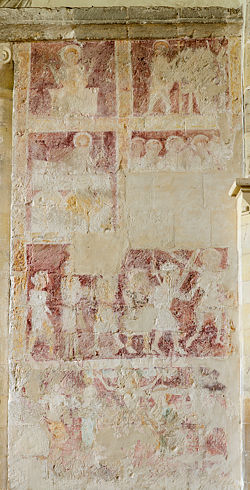
This quite small, oddly-organised and oddly-shaped painting has been misidentified in the past EW Tristram, obviously puzzled by the painting, spoke of ‘four nimbed figures, apparently survivals from a series of representations of Saints’.
In fact the painting is a Passion Cycle, arranged as usual in separate scenes, but within a tall and rather narrow overall frame apparently forced on the painter by the modest amount of available space on the south side of the chancel arch wall. There is little apparent logic in the arrangement of the scenes, which do not seem to follow any obvious chronology at all, although this may be illusory, as argued below.
In terms of the story, the earliest incident in the Cycle seems to be the combined Flagellation and Road to Calvary; together these form one of the clearer scenes, and in the photograph of the complete Cycle at the right it is the one spanning the width of the third tier from the top. The enlarged photograph below shows the details.
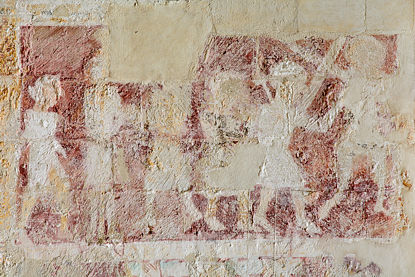
Here, at the left, is a torturer with an exaggeratedly grotesque profile, facing right. To his right stands Christ, facing the onlooker directly and with his feet overlapping the wide lower border of the scene. The slender column to which he is fastened shows faintly, and beyond him is another torturer, his head obliterated, but his figure facing left.
After this the scene simply becomes, without any kind of division, the Road to Calvary, with all three figures, including Christ carrying the Cross, moving right. One indistinct figure is at the rear of the procession, with beyond him to the right a man, probably a soldier, wearing a helmet, carrying a hammer, and pushing Christ along.
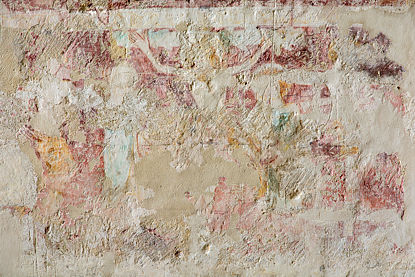
The next scene in chronological order is the one in the lowest tier of the Cycle, the Crucifixion. Christ is crucified between the two Thieves, traces of whom still remain. The Thief on the left is the clearer, his lower garment showing as a reddish-gold patch (probably not the original colour), his legs bent, and his entire crucified figure angled away from a forward-facing position in a similar way to the depiction of the Two Thieves in the Crucifixion at Barnby. The other Thief on the right has almost completely gone. Between the two Thieves and the central figure of Christ stand Mary and John, both very indistinct, but Mary on the left has traces of blue pigment¹ (also appearing on the horizontal bar of the Cross) on her robe, and St John on the right once had a green robe. A kneeling Longinus might once have been between Mary and Christ.
Chronologically, the next incident is the detail below, the right-hand scene in the second tier of the Cycle and shown at the lower left here. The lower part of this scene has gone completely, and the details are reduced to a row of four figures in contemplative attitudes.
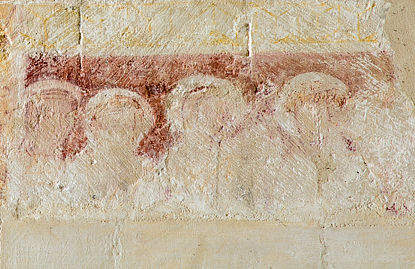
The first figure on the left is certainly female, as is, probably, the second from the left, while the figure at the far right is probably male and may be wearing some kind of headgear. All four have haloes. I think this scene is probably the Three Marys at the Tomb, with the male figure at the right Joseph of Arimathea. If so, then it is a rare scene, but not unique – there is another at Kempley in Gloucestershire, but that dates from the 12th century. Two others from Sussex – Hardham (even earlier than Kempley) and West Chiltington are forthcoming – and one in the Passion Cycle at Belchamp Walter in Essex is now here. The very well-preserved example at Winterbourne Dauntsey in Wiltshire now survives only as a drawing in EW Tristram’s 13th century volume³ (Plate 72)
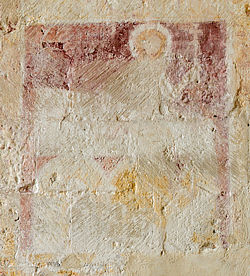
To the left of the Three Marys is the scene at the left of it in the complete Cycle and shown at the right here. It is readily identifiable as the Resurrection and thus the next incident in chronological order. Christ sits up in a wedge-shaped tomb recalling that of the woman donor at North Cove. His right hand seems to be on his hip, and he holds the Cross of the Resurrection. Confused details below are probably intended for the lid of the sepulchre, or possibly sleeping soldiers, but very little in the way of coherent shape or line can be made out.
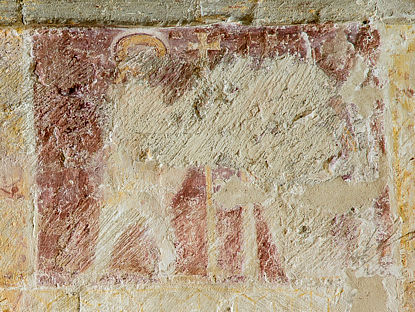
The final scene in the Passion Cycle proper is that at the top right of the Cycle and shown to the left. It is very fragmentary, but this is either the Appearance to Mary Magdalene, the Harrowing of Hell, or the Incredulity of Thomas, with the former the most, and the latter the least likely, I think. Christ is at the left, holding the Cross of the Resurrection again (the Cross itself is unclear in this detail, but clear in the photograph of the whole Cycle), with what is probably a tree to the right of that and perhaps a further one at the far right (scroll right). A large area between the two trees is very unclear, but there is no curve suggesting the Mouth of Hell, whereas on the other hand there is ample space for a figure of Mary Magdalene.
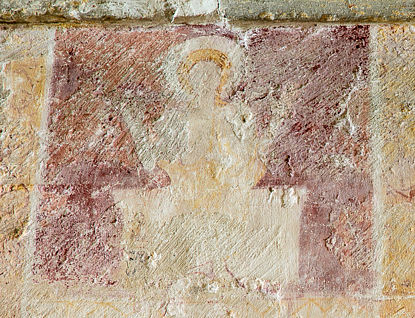
Finally, the remaining scene, i.e. that at the top left in the complete Cycle, and shown here to the right is not, I suggest, an incident in the Passion story at all, but a related scene combining devotional purpose and moral instruction. I think this the Risen Christ, sitting here, very probably, on his tomb rather than on a throne, and showing his wounds. The halo of the figure matches exactly the halo of Christ in the Resurrection scene – enough evidence to rule out an angel sitting on the tomb. The hands are raised palms outward in a display attitude, and there is a suggestion of a gold-coloured robe covering the right side of the torso but looped aside to bare the wounded side at the left (onlooker’s viewpoint).
It is a moralising conclusion to the Passion Story, very much in the spirit of the Warning to Sabbath Breakers. However, in many respects its closest relative on this site is the Image of Pity at Slapton.
It looks as though the Amberley painter or his patrons wanted to tell the story of the Passion in reverse, so to speak, with the Image of Pity introducing the events in Jerusalem. If we accept this, then the order and arrangement of scenes becomes natural enough, although a decision was evidently made to place the pivotal scene of the Crucifixion as the lowest scene in the arrangement. Perhaps this was done to ensure that it was directly before the eyes of the people in the nave.
All in all then, this is a complex painting, far more detailed and intriguing than at first appears. Dating it is difficult, but I think it is later than Tristram’s date (based on a very indistinct and partial view) of c.1300.
You can see a 360° panorama of the interior of the church here.
Website for Holy Trinity, Amberley
¹ Perhaps this is the place to point out that very convincing blue colour in this kind of medieval painting often has no blue pigment in it at all. Medieval artists were very skilled at ‘counterfeiting’ a greyish blue by a judicious mixture of red, black and white, although in the case of Amberley I think the traces of ‘blue’ pigment are likely to be the real thing.
Photos © Roy Reed 2019